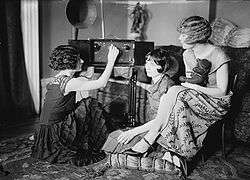Brox Sisters
The Brox Sisters were an American trio of singing sisters, enjoying their greatest popularity in the 1920s and early 1930s.

Early life
The sisters were:
- Lorayne (born Eunice, 11 November 1901 – 14 June 1993)
- Bobbe (born Josephine Brock, 28 November 1902 – 2 May 1999)
- Patricia (born Kathleen, 14 June 1904 – 27 August 1988).
The trio were born in Iowa and Indiana grew up in Alberta and Tennessee and retained Southern accents during their performing careers. “Eunice, Josephine and Kathleen Brock began a singing career as a trio in Canada, first appearing as child performers in Mother Lang's Children's Show. [1]
The family name "Brock" was changed to "Brox" for theater marquees.
They began in the 1910s touring the Vaudeville circuit in the United States and Canada. At the start of the 1920s they achieved success in New York on the Broadway stage.[2] Near the end of the decade they relocated to Los Angeles. The act broke up in the early 1930s after the sisters got married. They made their final professional reunion appearance on radio in 1939.
Broadway
The trio performed in Irving Berlin's Music Box Revue from 1921 to 1924, at the New York Theatre. Berlin's hit song "Everybody Step" was written for and debuted by the sisters.[3] They recorded a number of Berlin compositions, including "Bring on the Pepper," "How Many Times," "Lazy," "School House Blues," "Some Sunny Day," and "Tokio Blues."
In 1925 and 1926, they performed on Broadway in the musical comedy The Cocoanuts, with the Marx Brothers. In 1927, they appeared in the Ziegfeld Follies of 1927 at the New Amsterdam Theatre with comedian Eddie Cantor.
Film history
The Brox Sisters were among the earliest artists to appear on Warner Bros.' Vitaphone sound shorts in the late 1920s. They were featured in three productions: "Glorifying the American Song," "Down South" (both in 1928), and "Headin' South" (1929). None of these features currently exist in full audio and visual format, with research underway to locate missing visual or audio components.[4]
In 1929, they appeared in the film The Hollywood Revue of 1929, performing the songs "Singin' in the Rain" with Cliff Edwards and "Strike Up the Band" in the finale of the first act.
In 1930, the sisters appeared in the film King of Jazz. They performed the song "A Bench in the Park", with Joe Venuti and Eddie Lang, and with The Rhythm Boys (Bing Crosby, Harry Barris and Al Rinker). In that year they also appeared in the film Spring Is Here in which they performed the song "Crying for the Carolines".
They performed "Falling in Love Again" in the movie Hollywood on Parade (1932).
Radio and recordings
The sisters also made radio broadcasts in the 1920s. They recorded a series of phonograph records for Brunswick Records and Victor Records, as well as appearing on sides for Columbia.
References
- Aukerman, Cynthia, "Brox Sisters: from UC to Hollywood", The News Gazette (Winchester, Indiana), Jan 23, 2007
- "Brox Sisters". Red Hot Jazz Archive. Retrieved 13 April 2020.
- Bobbe Brox obituary
- The Vitaphone Project
External links
| Wikimedia Commons has media related to Brox Sisters. |
- The Brox Sisters at IMDB
- Bobbe Brox at IMDB
- Kathlyn Brox at IMDB
- Lorraine Brox at IMDB
- Bobbe Brox obituary at NY Times
- Brox Sisters pages at JazzAge 1920s site
- Brock Sisters from UC to Hollywood
- Bobbie Brox obit in The Independent
- Cameo performance in King of Jazz
- "Bobbe Van Heusen, original name: Josephine Van Heusen". Vocalist. Find a Grave. August 18, 1999. Retrieved October 28, 2011. (buried in Desert Memorial Park)
- "Lorraine Brox". Actress, Singer. Find a Grave. May 3, 2003. Retrieved October 28, 2011. (buried in Desert Memorial Park)